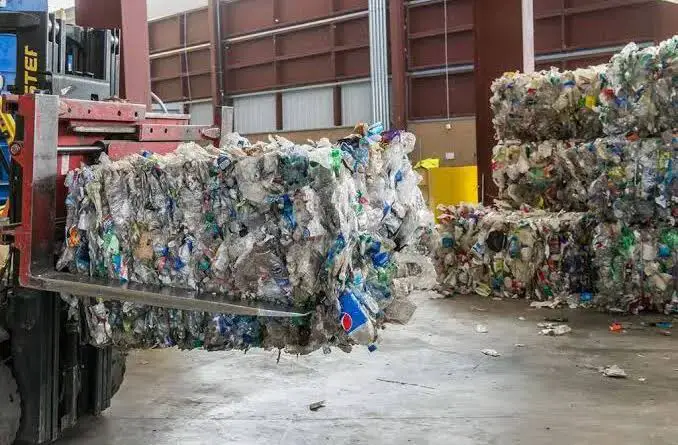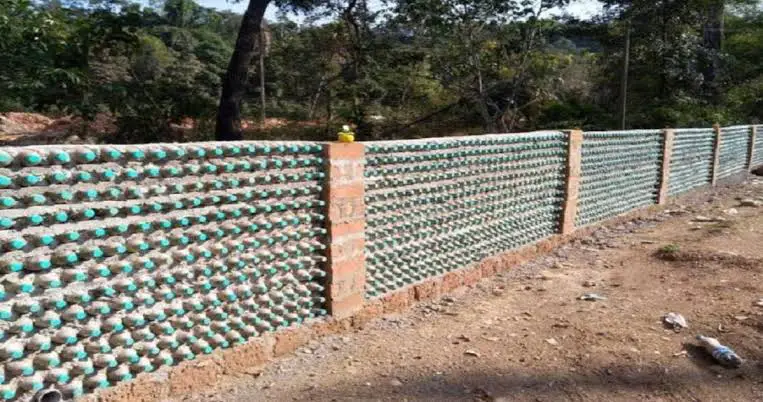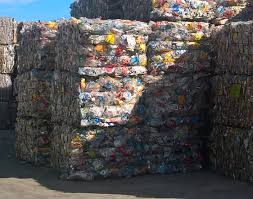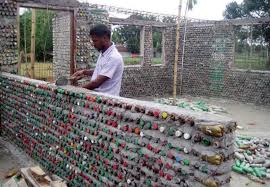Turning wastes into fencing; Plastic containers like bottles and jars, can become a big problem when we throw them away, they don’t break down easily, and they can harm the environment, but there’s a clever way to turn these plastic wastes into something useful: fencing.
Fencing is like a barrier that helps to mark boundaries or protect areas. Usually, it’s made from materials like wood or metal. But plastic containers can be recycled and turned into fencing too. Here’s how it works; First, people collect all the plastic containers they don’t need anymore. They make sure to clean them up and sort them by type. Then, these containers are sent to special places called recycling centers.
At the recycling center, the plastic containers are sorted again and grouped together. They are cleaned once more to make sure they’re ready for the next step. Then, the plastic containers are chopped up into tiny pieces, almost like little flakes.
Once the plastic is chopped up, it’s melted down and shaped into long, thin pieces. These pieces are then woven or molded together to make fencing panels. The panels can be different colors, depending on the types of plastic used.
Once the fencing panels are made, they’re ready to be used. People can install them around their homes, gardens, or even parks. This helps to keep areas safe and secure while also reducing the amount of plastic waste in the environment.
Using plastic containers to make fencing is a great idea because it gives new life to something that would otherwise be thrown away. It also helps to reduce the need for new materials, like wood or metal, which can be harmful to the environment when they’re produced. So, next time you have some plastic containers to throw away, think twice. They could be turned into something useful, like fencing, and help to protect our planet at the same time.
Read Also: Physic-Chemical Treatment Process
Types of Recyclable Plastic Containers (PVC) Wastes and their Uses

Plastic containers come in all shapes and sizes, and many of them can be recycled to create useful products. Here are some common types of recyclable plastic containers (including PVC) wastes and their potential uses:
1. PET Bottles (Polyethylene Terephthalate): PET bottles are commonly used for water, soda, and juice. They can be recycled into various items such as polyester fiber for clothing, carpet, and even new bottles.
2. HDPE Bottles (High-Density Polyethylene): HDPE bottles are often used for milk, detergent, and shampoo. They can be recycled into new bottles, plastic lumber for outdoor furniture, and pipes for plumbing.
3. PVC Containers (Polyvinyl Chloride): PVC containers are commonly found in packaging for food, cosmetics, and household products. While PVC can be more challenging to recycle due to its chemical composition, it can still be repurposed into products like vinyl flooring, synthetic leather, and even fencing.
4. LDPE Containers (Low-Density Polyethylene): LDPE containers include items like plastic bags, shrink wraps, and squeezable bottles. They can be recycled into new plastic bags, plastic lumber for decking, and even compost bins.
5. PP Containers (Polypropylene): PP containers are used for yogurt cups, margarine tubs, and medicine bottles. They can be recycled into items such as automotive parts, storage containers, and even garden furniture.
6. PS Containers (Polystyrene): PS containers include foam packaging, disposable cups, and take-out containers. They can be recycled into items like insulation materials, picture frames, and even office supplies.
By understanding the types of recyclable plastic containers and their potential uses, we can make informed choices about recycling and contribute to a more sustainable future. Recycling these materials not only conserves resources but also reduces pollution and waste in our environment.
How to Convert Plastic Containers (PVC) Wastes into Fencing

Converting plastic containers (PVC) wastes into fencing is a great way to repurpose materials and reduce environmental impact. Here’s a simple guide on how to do it:
1. Collect and Clean the Plastic Containers: Start by collecting plastic containers made of PVC. These could include bottles, jars, and other packaging items. Make sure to clean them thoroughly to remove any dirt, residue, or labels.
2. Sort and Prepare the Plastic Containers: Once cleaned, sort the plastic containers by color and type. This helps ensure a more uniform appearance in the final fencing product. Remove any non-PVC materials or contaminants from the containers.
3. Take the Containers to a Recycling Center: Transport the cleaned and sorted plastic containers to a recycling center that accepts PVC materials. These facilities have the equipment and expertise to process the plastic and turn it into usable material for fencing.
4. Chop and Shred the Plastic Containers: At the recycling center, the plastic containers will be chopped and shredded into small pieces. This increases the surface area of the plastic, making it easier to melt down and mold into fencing panels.
5. Melt and Shape the Plastic: The shredded plastic is then melted down in a controlled environment, usually using heat and pressure. Once melted, the plastic is shaped into long, thin strips or molded into pre-designed fencing panels.
6. Cool and Solidify the Fencing Panels: After shaping, the plastic fencing panels are allowed to cool and solidify. This ensures that they maintain their shape and durability once installed.
7. Install the Fencing: Finally, the recycled plastic fencing panels can be installed around desired areas. Whether it’s a garden, backyard, or public space, the fencing provides a functional and sustainable barrier while reducing the need for traditional materials like wood or metal.
By following these steps, you can effectively convert plastic containers (PVC) wastes into durable and eco-friendly fencing solutions. This not only helps to reduce plastic waste but also contributes to a more sustainable and environmentally conscious approach to fencing.
The Benefits of Converting Plastic Containers (PVC) Wastes into Fencing
Converting plastic containers (PVC) wastes into fencing offers a range of benefits for both the environment and society. Here are some of the key advantages:
1. Reduced Plastic Waste: By repurposing plastic containers into fencing, we can divert significant amounts of plastic waste from landfills and incinerators. This helps to alleviate the burden on waste management systems and reduces the environmental impact of plastic pollution.
2. Conservation of Resources: Creating fencing from recycled plastic containers reduces the need for new materials, such as wood or metal. This conserves natural resources and minimizes the environmental footprint associated with extracting and processing raw materials.
3. Energy Savings: Recycling plastic containers requires less energy compared to producing new plastic from virgin materials. By utilizing recycled plastics for fencing, we can reduce energy consumption and greenhouse gas emissions associated with the manufacturing process.
4. Durability and Longevity: Fencing made from recycled plastic containers is durable and long-lasting. It can withstand harsh weather conditions, UV exposure, and pests without rotting, rusting, or corroding. This results in lower maintenance requirements and longer service life compared to traditional fencing materials.
5. Versatility and Customization: Recycled plastic fencing can be manufactured in various styles, colors, and designs to suit different aesthetic preferences and functional requirements. It offers flexibility in terms of height, length, and configuration, allowing for customization to specific project needs.
6. Resistance to Decay and Corrosion: Unlike wood, which can rot or warp over time, and metal, which can rust or corrode, plastic fencing is resistant to decay and corrosion. It remains intact and retains its structural integrity even when exposed to moisture, chemicals, or pests.
7. Safety and Security: Plastic fencing provides a safe and secure barrier for residential, commercial, and industrial applications. It can effectively delineate property boundaries, protect sensitive areas, and enhance security without posing risks associated with sharp edges or protruding nails.
8. Promotion of Circular Economy: Converting plastic containers into fencing contributes to a circular economy by closing the loop on the plastic waste stream. It demonstrates the value of recycling and encourages the reuse of materials, promoting a more sustainable and resource-efficient approach to waste management.
Overall, converting plastic containers (PVC) wastes into fencing offers numerous environmental, economic, and social benefits. It represents a practical and innovative solution for addressing plastic pollution while providing functional and sustainable fencing solutions for various applications.
Read Also: Oxidation Pond Application
The Uses and Benefits of Recycled Fencing

Recycled fencing offers a multitude of uses and benefits, making it a versatile and eco-friendly option for various applications. Here are some of the key uses and benefits of recycled fencing:
Uses:
1. Property Boundaries: Recycled fencing can be used to delineate property boundaries for residential, commercial, and industrial properties. It provides a clear and aesthetically pleasing barrier that enhances privacy and security.
2. Garden Enclosures: Recycled fencing is ideal for creating garden enclosures, such as vegetable gardens, flower beds, or decorative landscaping features. It helps to protect plants from pests and provides structural support for climbing vines or trellises.
3. Livestock and Agriculture: Recycled fencing can be used in agricultural settings to contain livestock, such as cattle, horses, or poultry. It provides a sturdy and durable barrier that withstands the rigors of farming operations while ensuring the safety and well-being of animals.
4. Public Spaces: Recycled fencing is commonly used in public spaces, such as parks, playgrounds, and recreational areas. It helps to define boundaries, control access, and provide safety for visitors while blending harmoniously with the natural environment.
5. Security and Perimeter Protection: Recycled fencing is effective for enhancing security and perimeter protection around commercial and industrial facilities, construction sites, or utility installations. It serves as a deterrent to unauthorized access and vandalism while maintaining visibility and airflow.
6. Noise Reduction: Recycled fencing can help mitigate noise pollution in urban and suburban areas by acting as a sound barrier along highways, railways, or residential neighborhoods. It absorbs and deflects sound waves, reducing the transmission of noise to surrounding areas.
7. Erosion Control: Recycled fencing can be used in erosion control applications to stabilize slopes, prevent soil erosion, and protect sensitive ecosystems. It helps to retain soil and vegetation, mitigating the impact of runoff and sedimentation on water quality.
Benefits:
1. Environmental Sustainability: Recycled fencing reduces the demand for new materials and conserves natural resources, such as timber and metal. It promotes a circular economy by diverting waste from landfills and reducing the environmental footprint associated with manufacturing.
2. Energy Efficiency: Producing recycled fencing requires less energy compared to manufacturing new materials from virgin sources. It reduces greenhouse gas emissions and minimizes the environmental impact of the production process.
3. Durability and Longevity: Recycled fencing is durable, weather-resistant, and low-maintenance. It withstands exposure to UV radiation, moisture, insects, and rot, ensuring long-term performance and durability in various climates and environments.
4. Customization and Design Options: Recycled fencing offers flexibility in terms of design, style, and color options. It can be customized to complement architectural aesthetics, landscaping themes, or project specifications, enhancing visual appeal and curb appeal.
5. Cost-Effectiveness: Recycled fencing provides cost savings over the long term due to lower maintenance requirements and longer service life compared to traditional fencing materials. It offers a sustainable and economical solution for property owners, municipalities, and businesses.
6. Community Engagement: Installing recycled fencing demonstrates a commitment to environmental stewardship and sustainability. It fosters community engagement and pride by promoting eco-friendly practices and supporting local recycling initiatives.
Overall, recycled fencing offers a wide range of uses and benefits, making it a preferred choice for sustainable fencing solutions in residential, commercial, and public settings. It combines environmental responsibility with functional performance, durability, and aesthetic appeal, contributing to a greener and more resilient built environment.
The Challenges of Converting Plastic Containers (PVC) Wastes into Fencing and their Solutions
Converting plastic containers (PVC) wastes into fencing presents several challenges, but innovative solutions are available to address them effectively. Here are some common challenges and their corresponding solutions:
Challenges:
1. Contamination and Sorting: Plastic containers collected for recycling may contain contaminants such as food residue, labels, or other non-PVC materials. Sorting and cleaning these containers can be time-consuming and labor-intensive.
2. Chemical Composition: PVC has a unique chemical composition that requires specialized recycling processes. Traditional recycling methods may not be suitable for PVC, leading to limited recycling options and lower overall recycling rates.
3. Quality and Consistency: Recycled plastic materials may vary in quality and consistency, affecting the durability and performance of the resulting fencing products. Inconsistent feedstock and processing techniques can result in inferior end products.
4. Cost and Economics: Converting plastic containers into fencing may involve higher costs compared to traditional fencing materials like wood or metal. The initial investment in recycling infrastructure and equipment can be prohibitive for some recycling facilities.
5. Market Demand: The demand for recycled plastic fencing products may fluctuate depending on market trends, consumer preferences, and competing materials. Limited market demand can hinder the growth of the recycled plastics industry and discourage investment in recycling infrastructure.
Solutions:
1. Education and Outreach: Implement educational programs to raise awareness about the importance of proper recycling practices and the benefits of converting plastic containers into fencing. Encourage consumers to clean and sort their plastic waste to minimize contamination.
2. Technological Advancements: Invest in research and development of advanced recycling technologies specifically tailored to process PVC and other challenging plastics. Explore innovative techniques such as chemical recycling or advanced sorting systems to improve recycling rates and yield higher-quality recycled materials.
3. Quality Control Measures: Implement stringent quality control measures throughout the recycling process to ensure the consistency and reliability of recycled plastic materials. Develop standards and certifications for recycled plastic fencing products to guarantee their performance and durability.
4. Economic Incentives: Provide financial incentives, subsidies, or tax credits to support the development of recycling infrastructure and encourage investment in recycled plastics manufacturing. Explore partnerships with government agencies, industry stakeholders, and private investors to leverage funding opportunities.
5. Market Development: Foster partnerships with architects, contractors, and developers to promote the use of recycled plastic fencing in construction projects. Showcase the environmental benefits and cost savings associated with recycled plastics to attract customers and expand market demand.
By addressing these challenges through a combination of technological innovation, education, economic incentives, and market development efforts, the conversion of plastic containers (PVC) wastes into fencing can become more efficient, cost-effective, and environmentally sustainable.
Frequently Asked Questions (FAQs) About How to Convert Plastic Containers (PVC) Wastes into Fencing
1. Q: What types of plastic containers can be used to make recycled fencing?
A: Various types of plastic containers can be used, including PET bottles, HDPE bottles, PVC containers, LDPE containers, PP containers, and PS containers.
2. Q: How do I prepare plastic containers for recycling into fencing?
A: Start by cleaning the plastic containers thoroughly to remove any dirt, residue, or labels. Then, sort them by type and color to ensure uniformity in the final product.
3. Q: Where can I take my plastic containers for recycling into fencing?
A: Check with local recycling centers or facilities that accept PVC materials for recycling. They will have the equipment and expertise to process the plastic containers into fencing panels.
4. Q: What happens to the plastic containers once they are collected for recycling?
A: The plastic containers are sorted, cleaned, and shredded into small pieces. These pieces are then melted down and molded into fencing panels.
5. Q: Can recycled plastic fencing be customized to fit specific project requirements?
A: Yes, recycled plastic fencing can be customized in terms of design, color, height, length, and configuration to meet the needs of different projects.
6. Q: Is recycled plastic fencing durable and long-lasting?
A: Yes, recycled plastic fencing is durable, weather-resistant, and low-maintenance. It can withstand harsh weather conditions, UV exposure, and pests without rotting or corroding.
7. Q: How does recycled plastic fencing compare to traditional fencing materials in terms of cost?
A: While the initial cost of recycled plastic fencing may be higher, it offers long-term cost savings due to lower maintenance requirements and longer service life compared to traditional materials like wood or metal.
8. Q: What are the environmental benefits of using recycled plastic fencing?
A: Using recycled plastic fencing helps to reduce plastic waste in landfills, conserve natural resources, and minimize the carbon footprint associated with manufacturing new materials from virgin sources.
9. Q: Can recycled plastic fencing be recycled again at the end of its life cycle?
A: Yes, recycled plastic fencing can be recycled again at the end of its life cycle, closing the loop on the plastic waste stream and promoting a circular economy.
Read Also: Black Spot (Rose Disease): Description, Damages Caused, Control and Preventive Measures

